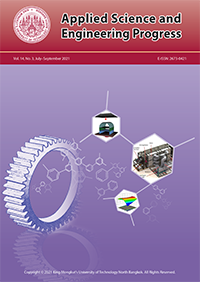Crashworthiness Investigation of Multi-stage Structures Designed for Underrun Protection Devices
Main Article Content
Abstract
Due to the disparity between large trucks and passenger vehicles, most deaths in large truck crashes are occupants in small cars, which under-ride the large truck. To protect the under-riding of small vehicles during crash and mitigate the severity, various designs of underrun protection devices have been developed to be installed at the front, side, rear of trucks. Not only can underrun protection devices protect a small vehicle from under-riding a truck, but also minimize the severity of crash to develop crashworthiness. In this paper, various cross section patterns of underrun protection device guard bar are designed with the aims to improve the crashworthiness. Moreover, the crashworthiness capability is clarified for future design guideline. The proposed structural configuration is designed from the concept of multi-stage energy absorption, which also results in an improvement of bending stiffness. To investigate the crashworthiness of the proposed design, the dynamic analysis is performed in LS-DYNA explicit commercial finite element analysis package. The guard bar is cut partially and investigated by performing drop impact test. Energy absorption, specific energy absorption, peak impact force, crash force efficiency, and stroke efficiency are considered as quantitative criteria for crashworthiness evaluation. The technique of order of preference by similarity to ideal solution is adopted to perform a multi-criteria decision analysis and identify the overall performance score of each design. The results indicate that the triple stage UPD guard bar yields the best performance score and improve the overall crashworthiness score up to 10% as compared with the rectangular design of standard UPD guard bar.
Article Details
References
[2] S. Koetniyom, S. Chanthanumataporn, M. Dangchat, S. Pangkreung, and C. Srisurangkul, “Technical effectiveness of ABS, non-ABS and CBS in step-through motorcycles,” Applied Science and Engineering Progress, to be published. doi: 10.14416/j.asep.2019.11.002.
[3] Federal Highway Administration “Highway Statistics 2017 - Policy | Federal Highway Administration,” Jul. 18, 2018. [Online]. Available: https://www.fhwa.dot.gov/policyinformation/ statistics/2017/
[4] D. Juodvalkis, J. Sapragonas, and P. Griškevičius, “Effects of spot welding on the functionality of thin-wall elements of car‘s deformation zone,” Mechanika, vol. 77, no. 3, pp. 34–39, 2009, doi: 10.5755/j01.mech.77.3.15229.
[5] B. S. Bloch, “Improved crashworthy designs for truck underride guards,” presented at the 16th International Technical Conference on the Enhanced Safety of Vehicles in Windsor, Ontario, Canada, Oct. 1998.
[6] D. Dailidonis and P. Griškevičius, “Crashworthiness simulations of side underrun protection devices,” in Proceedings of 15th International Conference. Mechanika, Jan. 2010, pp. 131–134.
[7] European Union, “Europa Summaries of EU legislation,” European Union, Bruxelles, Belgium, 2019.
[8] NHTSA, “FMVSS No. 223 Rear impact guards and FMVSS No. 224 Rear impact protection,” 2016. [Online]. Available: http://annaleahmary. com/wordpress/wp-content/uploads/2016/06/ Preliminary_Regulatory_Evaluation_-_Re_ NPRM_published_Dec_16_2015-1.pdf.
[9] United Nations Economic Commission for Europe, “UNECE No. 58 - Rear underrun protective devices (RUPDs),” United Nations Economic Commission for Europe, Geneva, Switzerland [Online]. Available: https://www. unece.org/fileadmin/DAM/trans/main/wp29/ wp29regs/r058r2e.pdf
[10] Z. F. Albahash and M. N. M. Ansari, “A review on rear under-ride protection devices for trucks,” International Journal of Crashworthiness, vol. 22, no. 1, pp. 95–109, 2017.
[11] J. Mariolani, A. De Arruda, and L. Schmutzler, “Development of new underride guards for enhancement of compatibility between trucks and cars,” presented at the Proceedings of 17th International Technical Conference on the Enhanced Safety of Vehicles, Amsterdam, Netherlands, 2001.
[12] M. Soltani, T. B. Moghaddam, M. R. Karim, and N. H. Ramli Sulong, “Analysis of developed transition road safety barrier systems,” Accident Analysis & Prevention, vol. 59, pp. 240–252, Oct. 2013, doi: 10.1016/j.aap.2013.05.029.
[13] L. Hong-fei, P. Tao, X. Hong-guo, T. Li-dong, and S. Li-li, “Research on the intelligent rear under-run protection system for trucks,” in 2010 8th World Congress on Intelligent Control and Automation, Jul. 2010, pp. 5274–5278, doi: 10.1109/WCICA.2010.5554843.
[14] J. Framby and D. Lantz, “Robustness and Reliability of Front Underrun Protection Systems,” M.S. thesis, Chalmers University of Technology, GÖteborg, Sweden, 2010.
[15] P. Galipeau-Bélair, “Design and development of side underride protection devices (SUPD) for heavy vehicles,” M.S. thesis, University of Ontario Institute of Technology, 2014.
[16] Z. F. Al-Bahash, M. N. M. Ansari, and Q. H. Shah, “Design and simulation of a rear underride protection device (RUPD) for heavy vehicles,” International Journal of Crashworthiness, vol. 23, no. 1, pp. 47–56, Jan. 2018, doi: 10.1080/13588265.2017.1302040.
[17] L. Xue and J. Yang, “A study on the application of energy-dissipating protection device in car-totruck rear underride,” in 2013 Fifth International Conference on Measuring Technology and Mechatronics Automation, Jan. 2013, pp. 130– 134, doi: 10.1109/ICMTMA.2013.43.
[18] G. Rechnitzer, C. T. Powell, and K. A. Seyer, “Development and testing of energy absorbing rear underrun barriers for heavy vehicles,” presented at the National Highway Traffic Safety Administration, Washington, DC, USA 1996.
[19] B. S. Min and J. U. Cho, “Impact characteristic according to the structure of crash box at the vehicle,” Archives of Metallurgy and Materials, vol. 62, no. 2B, 2017, doi: 10.1515/amm-2017-0151.
[20] D. F. M. Silva, C. M. A. Silva, I. M. F. Bragança, C. V. Nielsen, L. M. Alves, and P. A. F. Martins, “On the performance of thin-walled crash boxes joined by forming,” Materials (Basel), vol. 11, no. 7, Jun. 2018, doi: 10.3390/ma11071118.
[21] H. R. Zarei and M. Kröger, “Optimization of the foam-filled aluminum tubes for crush box application,” Thin-Walled Structures, vol. 46, no. 2, pp. 214–221, Feb. 2008, doi: 10.1016/j.tws. 2007.07.016.
[22] F. Usta and H. S. Türkmen, “Experimental and numerical investigation of impact behavior of nested tubes with and without honeycomb filler,” Thin-Walled Structures, vol. 143, p. 106256, Oct. 2019, doi: 10.1016/j.tws.2019.106256.
[23] C.-L. Hwang, Y.-J. Lai, and T.-Y. Liu, “A new approach for multiple objective decision making,” Computers and Operations Research, vol. 20, no. 8, pp. 889–899, Oct. 1993, doi: 10.1016/0305- 0548(93)90109-V.
[24] C.-L. Hwang and K. Yoon, Multiple Attribute Decision Making: Methods and Applications A State-of-the-Art Survey. Berlin, Germany: Springer-Verlag, 1981.
[25] W. Meethom and N. Koohathongsumrit, “An integrated potential assessment criteria and topsis based decision support system for road freight transportation routing,” Applied Science and Engineering Progress, to be published, doi: 10.14416/j.ijast.2019.01.002.


